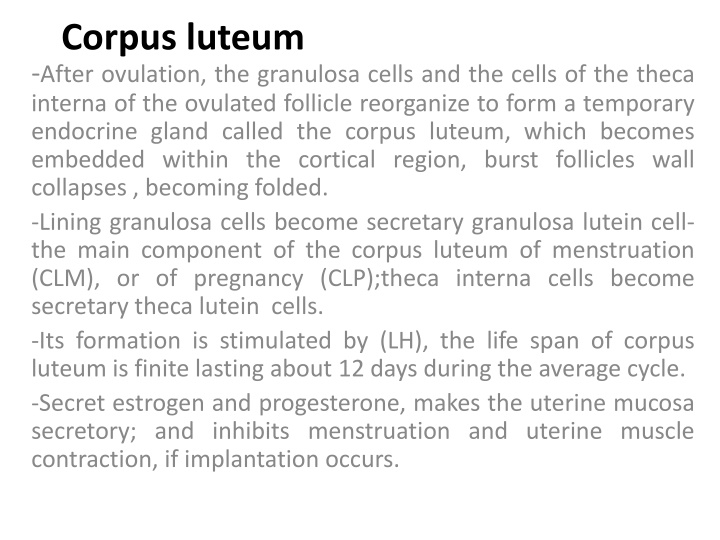
Understanding Corpus Luteum and Uterine Tube Anatomy
Learn about the formation and functions of the corpus luteum after ovulation, as well as the anatomy and role of the uterine tubes in catching oocytes and facilitating fertilization. Explore the changes in the corpus luteum during pregnancy and its importance in supporting early gestation. Dive into the composition of the oviduct walls and their essential functions in helping embryos move towards the uterus.
Uploaded on | 1 Views
Download Presentation

Please find below an Image/Link to download the presentation.
The content on the website is provided AS IS for your information and personal use only. It may not be sold, licensed, or shared on other websites without obtaining consent from the author. If you encounter any issues during the download, it is possible that the publisher has removed the file from their server.
You are allowed to download the files provided on this website for personal or commercial use, subject to the condition that they are used lawfully. All files are the property of their respective owners.
The content on the website is provided AS IS for your information and personal use only. It may not be sold, licensed, or shared on other websites without obtaining consent from the author.
E N D
Presentation Transcript
Corpus luteum -After ovulation, the granulosa cells and the cells of the theca interna of the ovulated follicle reorganize to form a temporary endocrine gland called the corpus luteum, which becomes embedded within the cortical region, burst follicles wall collapses , becoming folded. -Lining granulosa cells become secretary granulosa lutein cell- the main component of the corpus luteum of menstruation (CLM), or of pregnancy (CLP);theca interna cells become secretary theca lutein cells. -Its formation is stimulated by (LH), the life span of corpus luteum is finite lasting about 12 days during the average cycle. -Secret estrogen and progesterone, makes the uterine mucosa secretory; and inhibits menstruation and uterine muscle contraction, if implantation occurs.
-Late in pregnancy, or late in the menstrual cycle (if the shed oocyte Is not fertilized), the glandular lutein cells degenerate; the corpus luteum shrinks, and is replaced by a small pale mass of hyalinized CT- corpus albicans. -If pregnancy occurs, placental hormones maintain the corpus luteum, and it is known as the corpus luteum of pregnancy, this structure is functional for the first trimester of pregnancy.
Uterine tube(oviducts) Are paired ducts that catch the ovulated secondary oocyte, nourish both the oocyte and sperm, provide the microenvironment for fertilizllation, it has two ends, ovarian end and uterine end, and at this region the oviduct become narrow called Isthmus. The oviducts are divided in to four anatomical regions: _Infundibulum: the open end is finger like projection called Fimbria, facing the ovulated site during ovulation. _Ampulla : location of fertilization. _Isthmus : the narrow portion between the ampulla and uterus. _Intramural region: pass through the uterine wall to open in to the lumen of the uterus.
Their walls of oviducts composed of : _The wall of oviduct consist of a folded mucosa, has numerous branching, longitudinal folds that are most prominent in the ampulla, these mucosal folds become smaller in the segment of the tube closer to the uterus. _The epithelium (simple columnar epithelium) contains two interspersed, functionally important cell types: Ciliated cells and darker staining secretory cells, or peg cells, whose apical ends typically bulge into the lumen which produce glycoprotein's lubricating fluid covering the epithelium, the cilia beat toward the uterus, causing movement of the viscous liquid that covers the epithelial surface. _A thick muscular is with somewhat interwoven circular (or spiral) and longitudinal layers of smooth muscle, this and nutritive and
Layer contracts to move the embryo toward the uterus and its mucosa facilitate sperm and oocyte movement, and provides a nutritive and protective environment for fertilization and early embryonic development. _The serosa composed of simple squamous epithelium, the loose c.t between the serosa and the muscular is contains many blood vessels and nerve fibers.
